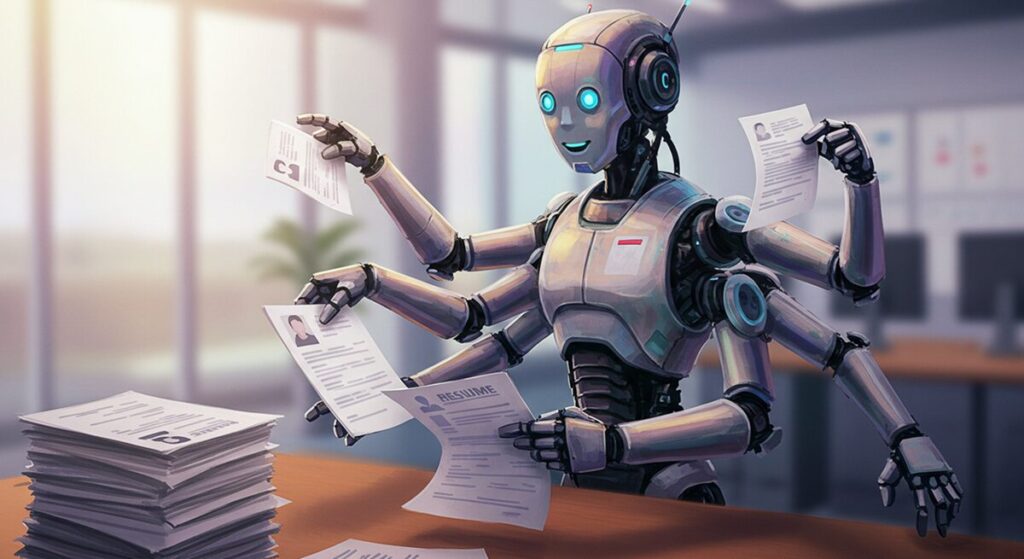Executive Snapshot
Job postings skyrocketed 61% globally in 2024
projected hiring gap due to lack of supply.
Surging Demand vs. Scarce Supply
Explosive demand for AI/ML talent defines 2025. Job postings skyrocketed 61% globally in 2024 (versus ~1.4% for all jobs), adding to roughly 80% growth in 2022-23. This demand far outpaces the supply of qualified professionals, creating a projected 50% hiring gap, intense employer competition, and a clear seller’s market.
The AI talent shortage directly hits business bottom lines
While AI adopters see nearly 5x higher labor productivity, 40-50% of executives call lack of talent a top AI implementation barrier. This gap slows innovation, raises costs, and creates risks like flawed deployments or security breaches from outsourcing sensitive work. Ultimately, this talent deficit strategically constrains growth, productivity, and innovation-far beyond being just an HR issue.
Key Global Metrics
- Only approximately 22,000 “true AI specialists” were identified globally in a 2022 study, a number dwarfed by the hundreds of thousands of open AI jobs.
- About 1.8% of all U.S. job postings now require AI skills, roughly double the share (~0.9%) observed in 2022.
- In tech hubs like Singapore, the demand is even more pronounced, with over 3% of job postings mentioning AI.
- Women represent only 30.5% of the global AI workforce, a figure that has remained stubbornly unchanged since 2016.
Important Trends
The AI talent market, after a brief cooling period in 2023 (partly due to tech sector layoffs), experienced a strong rebound in 2024, with AI hiring returning to growth in most countries.
The release of generative AI tools (like ChatGPT) in late 2022 initiated a new wave of investment and hiring specifically for generative AI-related skills throughout 2023 and 2024.
U.S. job postings explicitly requiring “generative AI” as a skill saw a fourfold increase in a single year, jumping from 16,000 in 2023 to over 66,000 in 2024.
Hiring increasingly focused on “AI-enabled” roles, where companies now expect professionals in fields like software development, product management, and analytics to have AI knowledge, not just individuals in pure AI research jobs.
In summary, the global AI talent gap has widened in 2024-2025, characterized by explosive demand growth, insufficient supply, and rising stakes for businesses. C-level leaders and investors are increasingly recognizing that closing this gap through aggressive recruitment, upskilling, and pipeline development is vital for maintaining competitive advantage in an AI-driven economy.
Market Dynamics
Demand Dynamics
Broad-Based Surge: AI Skills Permeate All Tech Roles
By 2024, nearly one out of every four new tech job ads asked for AI skills, double the number from 2022. Previously, companies mainly hired AI specialists like data scientists and machine learning engineers. Now, they also expect people in many other common tech roles, such as software developers, business analysts, and project managers, to use AI in their daily tasks.
Businesses are primarily seeking experienced AI professionals. While some entry-level AI positions exist, they are less common and often part of programs for new graduates. Consequently, companies across the board are looking for people who understand AI. Basic AI knowledge is becoming as essential as coding skills once was. This shift is pushing businesses to re-evaluate job roles, pay scales, and opportunities for career growth.
Generative AI Ignites New Wave of Specialized Hiring
When new AI tools that can create content, known as large language models, became public in late 2022, there was a sudden, big increase in demand for people with very specific AI skills. In the U.S., the number of job ads asking for “generative AI” skills grew four times in just one year. By 2024, there were over 66,000 of these job postings. This also led to new types of jobs, like those focused on improving these AI models or using them to create content.
Importantly, it’s not just research teams that need these skills. Many different departments are now hiring people who are experts in their field and can also use generative AI well. LinkedIn reported that the ability to develop and use these large language models is the fastest-growing software skill in 2025.
Sector-Specific Adoption and Evolving Role Specializations
All major industries are expanding their AI workforce, though the pace and hiring patterns vary significantly by sector. Technology companies continue to lead in AI recruitment, but financial services and healthcare are rapidly closing the gap, deploying AI for tasks like risk management, fraud detection, and medical diagnostics.
Notably, industries using AI strategically are seeing worker productivity increase nearly fivefold, creating a powerful cycle of investment and further hiring. While public sector and educational institutions have been slower to scale their AI teams, they too show steady growth in adopting AI talent.
As AI adoption spreads, the demand for specialized AI roles is also evolving. While core machine learning engineers and data scientists remain in high demand, there’s a growing need for newer specializations. These include MLOps (Machine Learning Operations) engineers to ensure AI systems run smoothly, AI reliability engineers, AI product managers, and AI ethicists, reflecting the shift towards managing real-world AI applications responsibly.
Supply-Side Realities
Education Pipeline and Experience Bottlenecks
The supply of skilled AI professionals still falls short of what companies need. In the U.S., nearly 20% of computer science PhD graduates now focus on AI, almost twice as many as ten years ago. Additionally, university undergraduate programs, MBA courses, and industry certifications from companies like Google and Microsoft are producing tens of thousands more AI-trained individuals annually.
However, there’s still a limited supply of AI specialists who are truly ready for complex job responsibilities. Businesses are facing a growing gap: on one hand, there are many beginners entering the field with certificates, but on the other, there are far fewer experienced engineers, data scientists, and research PhDs who can deliver significant results and lead projects immediately.
Regional Clusters, Global Mobility, and Remote Work Realities
Global AI expertise is highly concentrated in a few key hubs rather than being evenly distributed. The United States leads significantly, hosting about 60% of the world’s top AI experts and major AI centers. China also contributes substantially with numerous AI graduates and extensive research, though many of its specialists move to the U.S. or Europe seeking better opportunities. Meanwhile, India’s large pool of STEM graduates is rapidly expanding its AI-skilled workforce.
Beyond these major players, several smaller nations demonstrate exceptional AI capabilities for their size-Israel leads in AI professionals per capita, while Singapore and Luxembourg have high proportions of AI-related job postings. European countries like the UK, Germany, and France maintain active AI communities, though their talent is more dispersed than in the U.S. While traditional AI hub cities such as Toronto, London, and Shenzhen remain attractive due to their research, funding, and major employers.
Global Mobility, Remote Hiring, and Policy Responses
Distributed work models are reshaping access to the global AI talent pool, enabling firms to engage specialists in regions like Eastern Europe, Latin America, and Africa, often optimizing costs. Consequently, multinational corporations increasingly establish satellite AI centers in diverse urban locations such as Warsaw, Buenos Aires, Montreal, or Nairobi to secure expertise that is either scarce or prohibitively expensive at their primary operational bases.
Despite this trend, many remote opportunities maintain geographic restrictions, often limiting applicants by country or time zone, underscoring the continued relevance of operational proximity and legal frameworks. Furthermore, significant talent migration persists towards leading research institutions and more lucrative compensation packages, notably with many international graduates moving to established U.S. AI hubs.
In response to these global talent dynamics, national governments are implementing strategic initiatives, including targeted visa programs, research grants, and retention incentives, to attract and repatriate AI specialists-efforts notably undertaken by countries like Canada, the U.K., China, and the UAE.
Compensation & Economics
Regional Differentials on Compensation
Across the global market, pay for AI talent follows a steep gradient that mirrors both purchasing-power gaps and competitive intensity.
U.S. tech hubs sit at the peak: a mid-career machine-learning engineer in San Francisco, New York, or Seattle now commands a base salary of roughly $140 000 – $180 000, while principal research scientists at the largest platforms can clear $300 000 in cash and, with equity, exceed the half-million mark.
Western Europe pays well but at a discount of 30-50 percent; in Berlin or Paris, equivalent engineers earn about €70 000 – €120 000, reflecting lower local price levels and a still-maturing market.
Asia spans an even wider band. China’s big tech clusters offer CN¥300 000 – ¥500 000 ($45 000 – $75 000) for mid-level practitioners, competitive at home yet only a fraction of U.S. outlays, while Japan and Korea hover near $50 000 – $70 000. India remains the bargain location for in-country hiring domestic ML engineers typically make ₹1 – 2 million ($12 000 – $24 000), though many earn global rates once they join distributed teams.
These spreads fuel cost-arbitrage strategies firms open satellite AI centres in Warsaw, São Paulo, or Bangalore to capture 50-plus-percent labour savings-yet truly top-tier specialists gravitate to the highest bidders. Remote work is narrowing differentials at the margin, but for now compensation still follows a clear “Silicon Valley premium” curve.
Snapshot of Machine Learning Careers Across Various Markets
One clear consequence of the AI talent shortage is rapidly rising compensation. Skilled AI/ML practitioners command premium salaries and generous perks, as companies vie for a limited pool of experts. Here we examine current pay levels and regional differences:






















